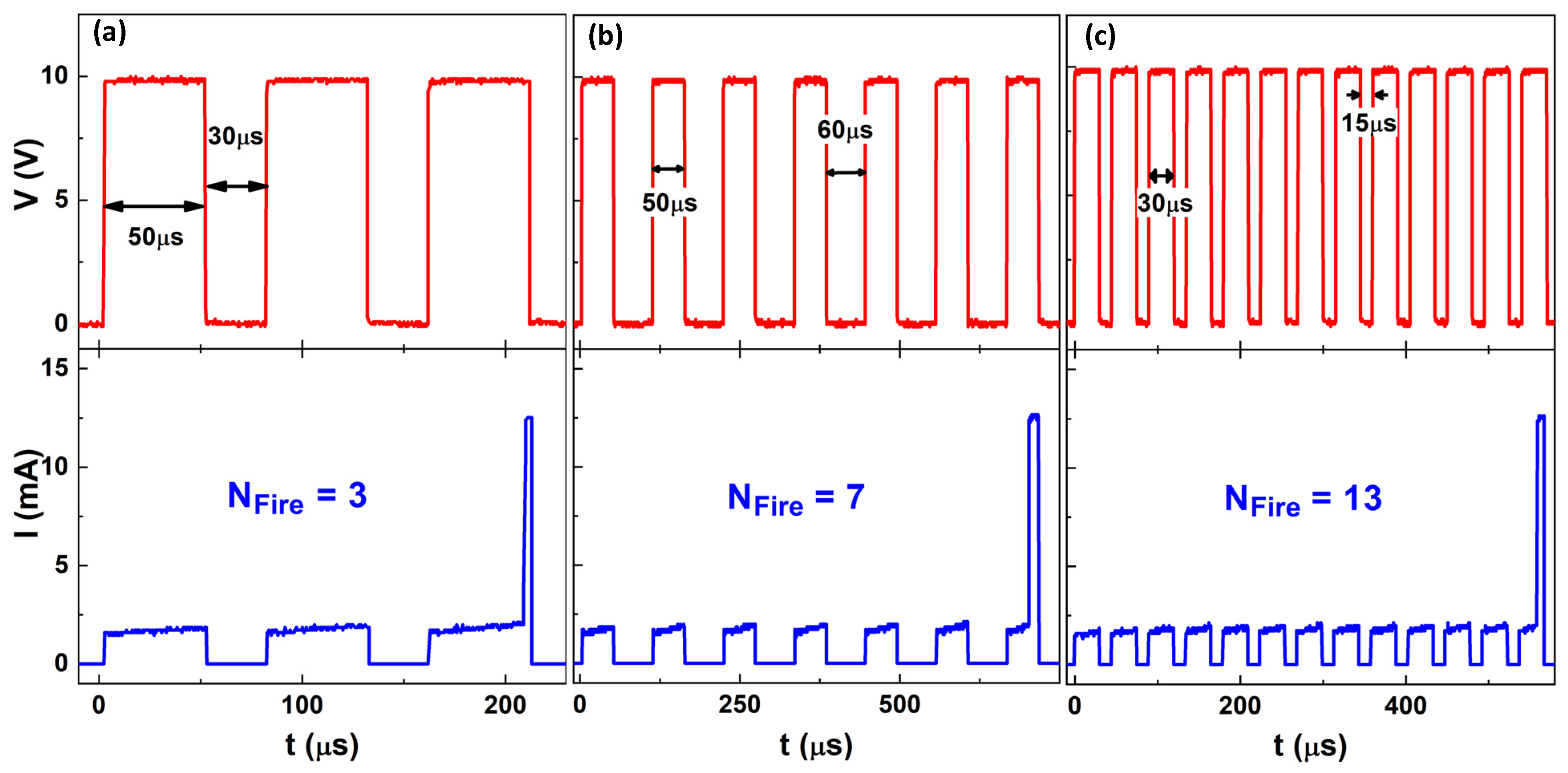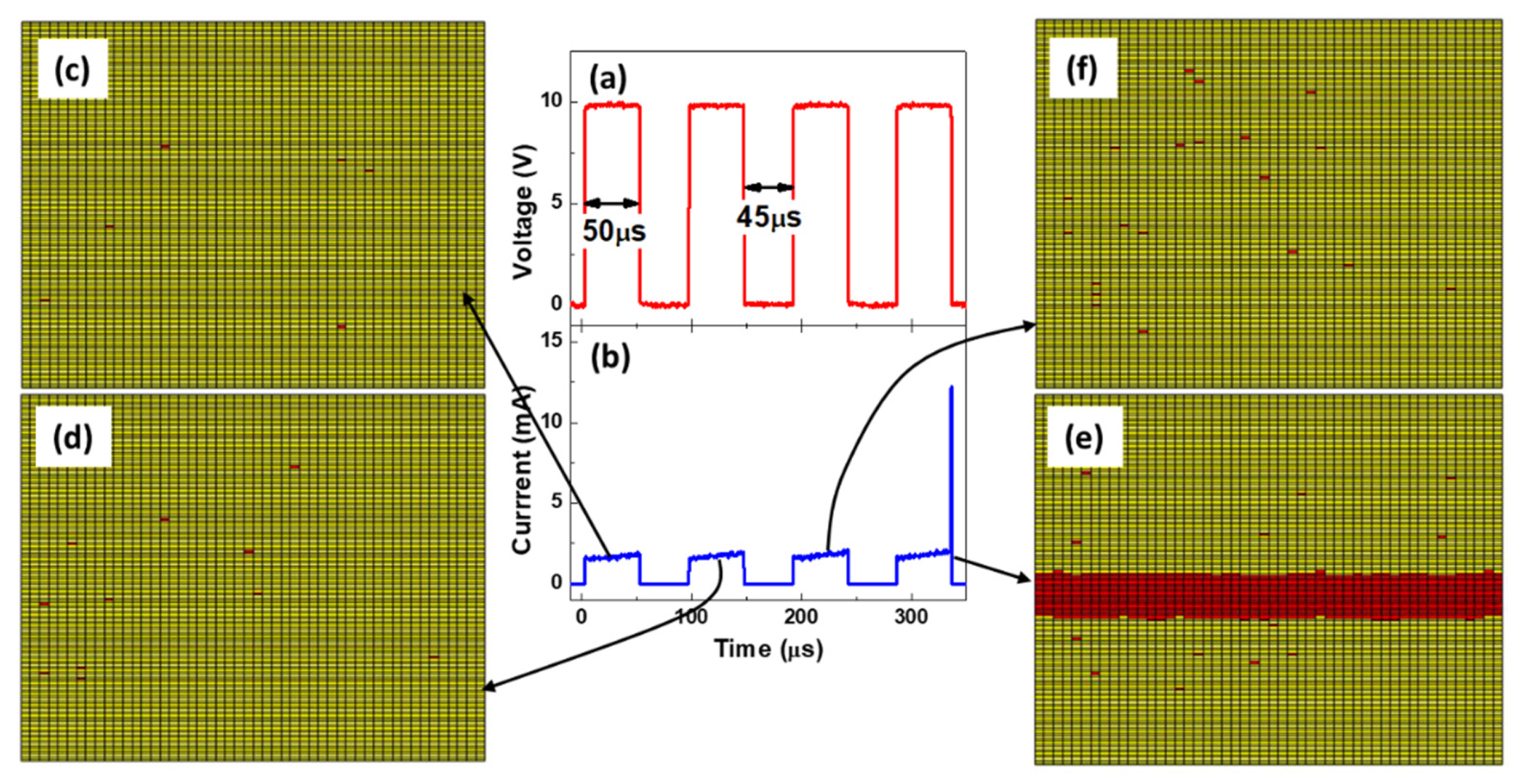Voltage Pulse Driven VO2 Volatile Resistive Transition Devices as Leaky Integrate-and-Fire Artificial Neurons
Abstract
:1. Introduction
2. Materials and Methods
3. Results
3.1. VO2 Material Properties
3.2. VO2 Behavior under Voltage Pulses
3.3. Simulating VO2 LIF Behavior
4. Discussion
5. Conclusions
Author Contributions
Funding
Conflicts of Interest
References
- Jain, A.K.; Mao, J.; Mohiuddin, K.M. Artificial neural networks: A tutorial. Computer 1996, 29, 31–44. [Google Scholar] [CrossRef] [Green Version]
- Kang, M.; Lee, Y.; Park, M. Energy efficiency of machine learning in embedded systems using neuromorphic hardware. Electronics 2020, 9, 1069. [Google Scholar] [CrossRef]
- Bouvier, M.; Valentian, A.; Mesquida, T.; Rummens, F.; Reyboz, M.; Vianello, E.; Beigne, E. Spiking neural networks hardware implementations and challenges: A survey. ACM J. Emerg. Technol. Comput. Syst. 2019, 15, 1–35. [Google Scholar] [CrossRef]
- Schuman, C.D.; Potok, T.E.; Patton, R.M.; Birdwell, J.D.; Dean, M.E.; Rose, G.S.; Plank, J.S. A survey of neuromorphic computing and neural networks in hardware. arXiv 2017, arXiv:1705.06963. [Google Scholar]
- Kim, M.-K.; Park, Y.; Kim, I.-J.; Lee, J.-S. Emerging Materials for Neuromorphic Devices and Systems. Iscience 2020, 23, 101846. [Google Scholar] [CrossRef] [PubMed]
- Burr, G.W.; Shelby, R.M.; Sebastian, A.; Kim, S.; Kim, S.; Sidler, S.; Virwani, K.; Ishii, M.; Narayanan, P.; Fumarola, A. Neuromorphic computing using non-volatile memory. Adv. Phys. X 2017, 2, 89–124. [Google Scholar] [CrossRef]
- Sangwan, V.K.; Hersam, M.C. Neuromorphic nanoelectronic materials. Nat. Nanotechnol. 2020, 15, 517–528. [Google Scholar] [CrossRef]
- Poon, C.-S.; Zhou, K. Neuromorphic silicon neurons and large-scale neural networks: Challenges and opportunities. Front. Neurosci. 2011, 5, 108. [Google Scholar] [CrossRef] [Green Version]
- Yu, S. Neuro-inspired computing with emerging nonvolatile memorys. Proc. IEEE 2018, 106, 260–285. [Google Scholar] [CrossRef]
- Zidan, M.A.; Strachan, J.P.; Lu, W.D. The future of electronics based on memristive systems. Nat. Electron. 2018, 1, 22–29. [Google Scholar] [CrossRef]
- Park, J. Neuromorphic Computing Using Emerging Synaptic Devices: A Retrospective Summary and an Outlook. Electronics 2020, 9, 1414. [Google Scholar] [CrossRef]
- Kim, K.-H.; Gaba, S.; Wheeler, D.; Cruz-Albrecht, J.M.; Hussain, T.; Srinivasa, N.; Lu, W. A functional hybrid memristor crossbar-array/CMOS system for data storage and neuromorphic applications. Nano Lett. 2011, 12, 389–395. [Google Scholar] [CrossRef] [PubMed]
- Jeong, D.S.; Kim, I.; Ziegler, M.; Kohlstedt, H. Towards artificial neurons and synapses: A materials point of view. RSC Adv. 2013, 3, 3169–3183. [Google Scholar] [CrossRef]
- Del Valle, J.; Ramírez, J.G.; Rozenberg, M.J.; Schuller, I.K. Challenges in materials and devices for resistive-switching-based neuromorphic computing. J. Appl. Phys. 2018, 124, 211101. [Google Scholar] [CrossRef]
- Indiveri, G.; Linares-Barranco, B.; Hamilton, T.J.; Van Schaik, A.; Etienne-Cummings, R.; Delbruck, T.; Liu, S.-C.; Dudek, P.; Häfliger, P.; Renaud, S. Neuromorphic silicon neuron circuits. Front. Neurosci. 2011, 5, 73. [Google Scholar] [CrossRef] [Green Version]
- Stoliar, P.; Akita, I.; Schneegans, O.; Hioki, M.; Rozenberg, M. A spiking neuron implemented in VLSI. J. Phys. Commun. 2022, 6, 021001. [Google Scholar] [CrossRef]
- Lu, Y.-F.; Li, Y.; Li, H.; Wan, T.-Q.; Huang, X.; He, Y.-H.; Miao, X. Low-power artificial neurons based on Ag/TiN/HfAlOx/Pt threshold switching memristor for neuromorphic computing. IEEE Electron. Device Lett. 2020, 41, 1245–1248. [Google Scholar] [CrossRef]
- Tuma, T.; Pantazi, A.; Le Gallo, M.; Sebastian, A.; Eleftheriou, E. Stochastic phase-change neurons. Nat. Nanotechnol. 2016, 11, 693–699. [Google Scholar] [CrossRef]
- Dutta, S.; Schafer, C.; Gomez, J.; Ni, K.; Joshi, S.; Datta, S. Supervised learning in all fefet-based spiking neural network: Opportunities and challenges. Front. Neurosci. 2020, 14, 634. [Google Scholar] [CrossRef]
- Kurenkov, A.; DuttaGupta, S.; Zhang, C.; Fukami, S.; Horio, Y.; Ohno, H. Artificial neuron and synapse realized in an antiferromagnet/ferromagnet heterostructure using dynamics of spin–orbit torque switching. Adv. Mater. 2019, 31, 1900636. [Google Scholar] [CrossRef]
- Stoliar, P.; Tranchant, J.; Corraze, B.; Janod, E.; Besland, M.-P.; Tesler, F.; Rozenberg, M.; Cario, L. A Leaky-Integrate-and-Fire Neuron Analog Realized with a Mott Insulator. Adv. Funct. Mater. 2017, 27, 1604740. [Google Scholar] [CrossRef]
- Pickett, M.D.; Medeiros-Ribeiro, G.; Williams, R.S. A scalable neuristor built with Mott memristors. Nature Mater. 2013, 12, 114–117. [Google Scholar] [CrossRef] [PubMed]
- Shao, Z.; Cao, X.; Luo, H.; Jin, P. Recent progress in the phase-transition mechanism and modulation of vanadium dioxide materials. NPG Asia Mate. 2018, 10, 581–605. [Google Scholar] [CrossRef] [Green Version]
- Shi, R.; Shen, N.; Wang, J.; Wang, W.; Amini, A.; Wang, N.; Cheng, C. Recent advances in fabrication strategies, phase transition modulation, and advanced applications of vanadium dioxide. Appl. Phys. Rev. 2019, 6, 011312. [Google Scholar] [CrossRef]
- Karaoglan-Bebek, G.; Hoque, M.; Holtz, M.; Fan, Z.; Bernussi, A. Continuous tuning of W-doped VO2 optical properties for terahertz analog applications. Appl. Phys. Lett. 2014, 105, 201902. [Google Scholar] [CrossRef] [Green Version]
- Chen, Z.; Gao, Y.; Kang, L.; Du, J.; Zhang, Z.; Luo, H.; Miao, H.; Tan, G. VO2-based double-layered films for smart windows: Optical design, all-solution preparation and improved properties. Sol. Energy Mater. Sol. Cells 2011, 95, 2677–2684. [Google Scholar] [CrossRef]
- Balberg, I.; Trokman, S. High-contrast optical storage in VO2 films. J. Appl. Phys. 1975, 46, 2111–2119. [Google Scholar] [CrossRef]
- Stefanovich, G.; Pergament, A.; Stefanovich, D. Electrical switching and Mott transition in VO2. J. Phys. Condens. Matter 2000, 12, 8837. [Google Scholar] [CrossRef]
- Xu, Z.; Qin, G.; Bernussi, A.A.; Fan, Z. Electrothermally control of dynamic infrared switching of VO2 thin film on FTO glass. J. Alloys Compd. 2021, 858, 157640. [Google Scholar]
- Hoque, M.N.F.; Karaoglan-Bebek, G.; Holtz, M.; Bernussi, A.A.; Fan, Z. High performance spatial light modulators for terahertz applications. Opt. Commun. 2015, 350, 309–314. [Google Scholar] [CrossRef]
- Dutta, S.; Khanna, A.; Assoa, A.; Paik, H.; Schlom, D.; Toroczkai, Z.; Raychowdhury, A.; Datta, S. An Ising Hamiltonian solver based on coupled stochastic phase-transition nano-oscillators. Nat. Electron. 2021, 4, 502–512. [Google Scholar] [CrossRef]
- Shi, Y.; Duwel, A.E.; Callahan, D.M.; Sun, Y.; Hong, F.A.; Padmanabhan, H.; Gopalan, V.; Engel-Herbert, R.; Ramanathan, S.; Chen, L.-Q. Dynamics of voltage-driven oscillating insulator-metal transitions. Phys. Rev. B 2021, 104, 064308. [Google Scholar] [CrossRef]
- Bohaichuk, S.M.; Kumar, S.; Pitner, G.; McClellan, C.J.; Jeong, J.; Samant, M.G.; Wong, H.-S.P.; Parkin, S.S.; Williams, R.S.; Pop, E. Fast spiking of a Mott VO2–carbon nanotube composite device. Nano Lett. 2019, 19, 6751–6755. [Google Scholar] [CrossRef] [PubMed] [Green Version]
- Pattanayak, M.; Hoque, M.N.F.; Zhao, Y.; Fan, Z.; Bernussi, A.A. Tunable VO2 relaxation oscillators for analog applications. Semicond. Sci. Technol. 2019, 34, 105028. [Google Scholar] [CrossRef]
- Yi, W.; Tsang, K.K.; Lam, S.K.; Bai, X.; Crowell, J.A.; Flores, E.A. Biological plausibility and stochasticity in scalable VO2 active memristor neurons. Nat. Commun. 2018, 9, 1–10. [Google Scholar] [CrossRef]
- Belyaev, M.; Velichko, A. A Spiking Neural Network Based on the Model of VO2–Neuron. Electronics 2019, 8, 1065. [Google Scholar] [CrossRef] [Green Version]
- Zhao, Y.; Hwan Lee, J.; Zhu, Y.; Nazari, M.; Chen, C.; Wang, H.; Bernussi, A.; Holtz, M.; Fan, Z. Structural, electrical, and terahertz transmission properties of VO2 thin films grown on c-, r-, and m-plane sapphire substrates. J. Appl. Phys. 2012, 111, 053533. [Google Scholar] [CrossRef]
- Zhao, Y.; Hao, J.; Chen, C.; Fan, Z. Electrically controlled metal–insulator transition process in VO2 thin films. Phys. Condens. Matter 2011, 24, 035601. [Google Scholar] [CrossRef]
- Poklonski, N.; Kocherzhenko, A.; Benediktovitch, A.; Mitsianok, V.; Zaitsev, A. Simulation of dc conductance of two-dimensional heterogeneous system: Application to carbon wires made by ion irradiation on polycrystalline diamond. Phys. Status Solidi 2006, 243, 1212–1218. [Google Scholar] [CrossRef] [Green Version]
- Stoliar, P.; Cario, L.; Janod, E.; Corraze, B.; Guillot-Deudon, C.; Salmon-Bourmand, S.; Guiot, V.; Tranchant, J.; Rozenberg, M. Universal Electric-Field-Driven Resistive Transition in Narrow-Gap Mott Insulators. Adv. Mater. 2013, 25, 3222–3226. [Google Scholar] [CrossRef] [Green Version]
- Madan, H.; Jerry, M.; Pogrebnyakov, A.; Mayer, T.; Datta, S. Quantitative mapping of phase coexistence in Mott-Peierls insulator during electronic and thermally driven phase transition. ACS Nano 2015, 9, 2009–2017. [Google Scholar] [CrossRef] [PubMed]
- Stoliar, P.; Rozenberg, M.; Janod, E.; Corraze, B.; Tranchant, J.; Cario, L. Nonthermal and purely electronic resistive switching in a Mott memory. Phys. Rev. B 2014, 90, 045146. [Google Scholar] [CrossRef]
- Pickett, M.D.; Williams, R.S. Sub-100 fJ and sub-nanosecond thermally driven threshold switching in niobium oxide crosspoint nanodevices. Nanotechnology 2012, 23, 215202. [Google Scholar] [CrossRef] [PubMed]
- Pattanayak, M.; Hoque, M.N.F.; Fan, Z.; Bernussi, A.A. Electrical oscillation generation with current-induced resistivity switching in VO2 micro-channel devices. Sci. Technol. Adv. Mater. 2018, 19, 693–701. [Google Scholar] [CrossRef] [Green Version]
- Izhikevich, E.M. Which model to use for cortical spiking neurons? IEEE Trans. Neural Netw. 2004, 15, 1063–1070. [Google Scholar] [CrossRef]
- Jerry, M.; Ni, K.; Parihar, A.; Raychowdhury, A.; Datta, S. Stochastic insulator-to-metal phase transition-based true random number generator. IEEE Electron. Device Lett. 2017, 39, 139–142. [Google Scholar] [CrossRef]






Publisher’s Note: MDPI stays neutral with regard to jurisdictional claims in published maps and institutional affiliations. |
© 2022 by the authors. Licensee MDPI, Basel, Switzerland. This article is an open access article distributed under the terms and conditions of the Creative Commons Attribution (CC BY) license (https://creativecommons.org/licenses/by/4.0/).
Share and Cite
Xu, Z.; Bernussi, A.A.; Fan, Z. Voltage Pulse Driven VO2 Volatile Resistive Transition Devices as Leaky Integrate-and-Fire Artificial Neurons. Electronics 2022, 11, 516. https://doi.org/10.3390/electronics11040516
Xu Z, Bernussi AA, Fan Z. Voltage Pulse Driven VO2 Volatile Resistive Transition Devices as Leaky Integrate-and-Fire Artificial Neurons. Electronics. 2022; 11(4):516. https://doi.org/10.3390/electronics11040516
Chicago/Turabian StyleXu, Zhen, Ayrton A. Bernussi, and Zhaoyang Fan. 2022. "Voltage Pulse Driven VO2 Volatile Resistive Transition Devices as Leaky Integrate-and-Fire Artificial Neurons" Electronics 11, no. 4: 516. https://doi.org/10.3390/electronics11040516
APA StyleXu, Z., Bernussi, A. A., & Fan, Z. (2022). Voltage Pulse Driven VO2 Volatile Resistive Transition Devices as Leaky Integrate-and-Fire Artificial Neurons. Electronics, 11(4), 516. https://doi.org/10.3390/electronics11040516






